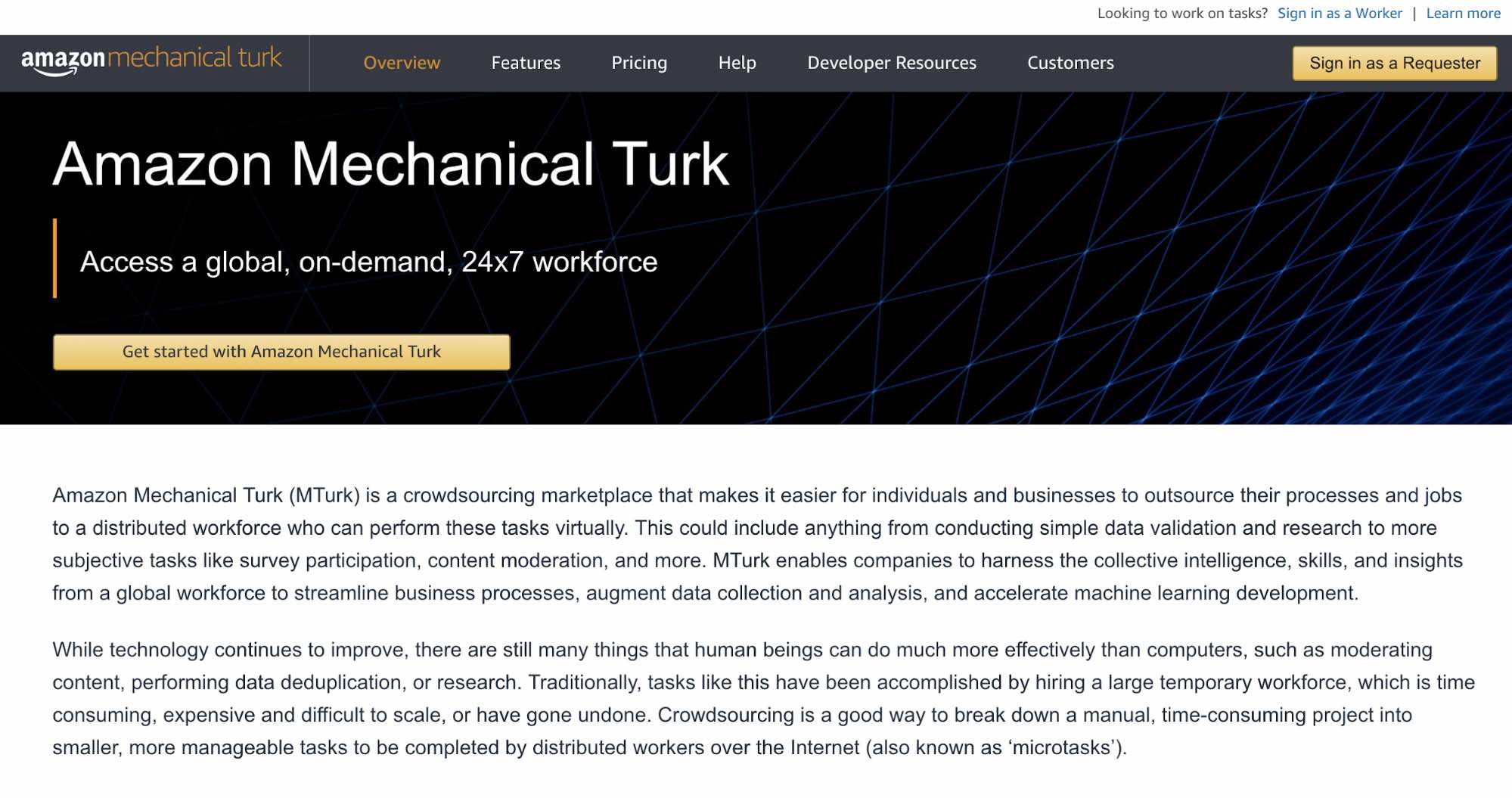Freelancer and Upwork are freelancing sites that facilitate and streamline the process of hiring virtual or remote workers.
Each of these sites have their own approach, but in essence, all of these companies allow you to do more or less the same thing.
You can post a job description, have people bid on the work, negotiate on price, and look at previous ratings and work history before settling on either a contract rate, or a pay-per hour agreement.
Generally, money is held by each of the websites in an escrow account, and they release the payment to the worker when the work is complete (skimming a neat profit at the same time – typically 10-15% of the money that changes hands).
The best outsourcing websites
- Upwork
- Freelancer.com
- Guru
- Amazon’s Mechanical Turk
- DesignHill
- Fiverr
Read on as we will review each of them later.
See how Time Doctor’s easy-to-use time tracking software can help your team be more productive.
So why outsource?
Freelancer (an online job marketplace acquired by Freelancer in 2012) argues that online outsourcing makes workers “more accountable”.
With 54% of traditional workers in the U.S. “sleepwalk through their day” and an additional 18% actively sabotage other workers, a Gallup Research says, “in today’s competitive environment, that’s simply unacceptable,” says Freelancer founder Ian Ippolito.
“When I hire a traditional employee, I can’t be sure they’ll do the job right, spending time at the water cooler or playing solitaire instead. But in our virtual environment, we’re proud to guarantee performance,” Ippolito said.
The added flexibility of having to hire staff only when you need them is another reason why many businesses are turning to online outsourcing. You also can get access to top quality people at a much lower rate than if you were hiring in your own country and the cost savings can be very significant.
To hire a quality programmer in California is probably going to set you back $80-$120 per hour.
Using outsourced web sites you can find quality programmers in the US for $30-$40 per hour, or in India, the Philippines or Russia for $10-$15 per hour.
Additional Tips:
If you are managing remote teams, take a look at these strategies for managing virtual teams. See also the online collaboration tools to help your team be more productive.
Outsourcing and freelancing sites allow entrepreneurs to easily launch side hustles and affiliate sites without incurring huge labor costs.
Getting started
Outsourcing can be overwhelming at first – each of these sites uses a different system, have a different layout and can take days to get used to.
Deciding on which site to use while striking the balance between competitive rates and effective results can be like walking a virtual tightrope.
As mentioned above, all of these sites will require you to:
- Post your job.
- Start receiving proposals from candidates.
- Compare profiles, reviews, ratings, credentials, portfolios and price to select the best fit. Methods of payment and working together generally vary from site to site (explained in more detail below).
We ourselves have been active in online outsourcing for over 10 years and our virtual team extends to several countries around the world. We’ve used these sites many times for many different projects (small and large).
Here’s what we know.
Based on Compete.com rankings, these six sites are the top outsourcing sites on the internet (at least in terms of traffic). From most to least popular:
1. Upwork

How it works: Pay only for verified time spent working for you – Upwork’s Work Diary software allows you to see each of team members activity levels (keyboard and mouse activity), and feedback, as well as web cams and screenshots of their computer to make workers more accountable.
Payments: Based on hours worked, or completed jobs.
Fees: The fee is 10% of the employer’s payment to Upwork which equates to 11.11% on top of the amount paid to the contractor.
Our experience: Upwork is great when you have a task where you’d prefer to pay by the hour. Also, note that Upwork is formerly oDesk, which merged with Elance in 2013.
Check out our comprehensive Upwork review if you want to go into more detail about the platform.
2. Freelancer.com

How it works: When you hire a worker you need to create payment milestones, as milestones are completed, payment is released.
Payments: Based on milestones, or completed work.
Fees: Here’s where it gets messy:
- Posting a project – $5, refundable, fully refunded on selecting a Service Provider.
- Selecting a Service Provider – $3 or 3%, whichever is higher
- Posting a Featured Project – $19
- Hide Project from Search Engines – $3
- Optional Hide Bids from Other Users – $3
- Gold Membership – $24.95/month, 0% project commissions
- Posting a Full Time Project – $99.95
Our experience: Better for project based work (one off jobs). Easy to use, and suited to smaller jobs – “The average job is under US$200, making outsourcing for the first time extremely cost effective for small businesses.
We also have a full Freelancer review if you want to learn more.
3. Guru

How it works: Pay for completed work.
Fees: Memberships are available from $29.95 to $99.95 per quarter.
- Project Fee – Either 5 or 10% of the Invoice or Escrow amount, depending on your membership level.
- Escrow Fee – 2% of the escrowed amount. Only charged when SafePay Escrow is used.
- Employer Payment Method Fees – Up to 4% for a credit card payment and 2.5% for Withdraw Method Fees – $3 to receive funds by check and $9 to receive funds by wire transfer.
Our experience: Caters more to US based freelancers (182,000 workers in the US vs 51,242 in India, and only 1,887 in the Russian Federation). Working with a native English speaker is sometimes a good option when you need to be able to verbally communicate project requirements.
Guru is also a good option if you are looking to work with a US based provider.
4. Amazon’s Mechanical Turk

How it works: This platform provides developers with access to an on-demand workforce with a flexible UI with a simple API.
Organizations use crowdsourcing via MTurk for help with things like microwork, human insights, and machine learning development.
Fees: You decide how much to pay the person you hire.
MTurk fee:
- 20% fee on the reward and bonus amount (if any) you pay Workers.
- HITs with 10 or more assignments will be charged an additional 20% fee on the reward you pay Workers.
- The minimum fee is $0.01 per assignment or bonus payment.
Masters qualification fee:
- There is an additional fee for using the Masters Qualification.
- The fee is 5% of the reward you pay Workers.
Premium qualifications:
- There is an additional fee for using Premium Qualifications.
- The additional fee per assignment starts at $0.05 and varies depending on the qualification.
Our experience: It’s a strange name, but it has some great functionality. MTurk is based on the idea of taking a job and separating it out for many different people to work on (in pieces).
It’s an interesting approach and worth checking it out if that approach fits your project requirements.
5. DesignHill

How it works: Post a brief where you describe your project, choose a package, and then launch your design project.
You’ll browse dozens of designs that designers submit to your contest. Then, you can give feedback and get unlimited revisions. You get to choose the best one when all is said and done.
Fees: Fees vary depending on which package you select. Fees vary from $199-$999.
Our experience: This is a good option if you have a limited budget for graphic design and/or want to choose from more style than one.
The crowdsourcing option gives you the opportunity to limit down designers until you’ve found the one you like the best.
6. Fiverr

How it works: Professional freelancers post “gigs” and buyers can review the gig, contact the seller, and see the price.
Once a gig catches a buyer’s eye, they can enter into an agreement and start working on a project together.
Fees: The buyer will pay full price of the gig, usually via PayPal or CC, the seller keeps 80%, and Fiverr keeps the other 20%. If a gig costs the traditional $5, the seller keeps $4, and Fiverr keeps $1.
Our experience: Fiverr started out with most freelancers posting their services for $5. Freelancers can now post their starting rate, and also provide add-ons. Even though gigs sometimes cost more than $5, the prices are still outrageously low. It’s possible to strike gold and find remote work for very reasonable prices.
You can also try out the other sites like Fiverr for the more reasonable prices for the different tasks.
Which site is best?
In short, it depends on the type of work that you are doing.
For hourly work, Upwork is possibly the best option. For one off project based work, Guru and Freelancer.com are great options as they have a process where you upload funds into escrow (giving the provider and reassurance).
Disputes over completed work are usually handled swiftly – although it’s important to have a clear job description (see below – Tips for posting jobs). In our experience Freelancer is best for getting project based work completed.
Guru is great if you are looking for a US based provider. With Upwork the providers often have to pay to bid on projects. This provides a bar that eliminates some of the lower quality providers. The result is that you are more likely to pay a little more, but you are also more likely to get a good end result. Places like Fiverr have workers all over the world, but the prices are also more than fair.
If you are looking for a specific type of work, DesignHill and MTurk are more focused. These might be a great place to start if you know what you want, and want to only hire a designer, for example.
It’s hard to say which site is the best, because it depends on your preferences, your goals, your budget, and how you like to work with remote workers.
Each outsourcing website is different, and you’ll get different features, different benefits, different types of remote workers, and different expertise. The best idea is to check them all out and see what works best for you individually.
Comparing the software used to monitor paid by the hour work
If you are hiring on an hourly basis you’ll want to monitor how many hours are worked (and confirm they were actually worked).
If you develop trust in someone you might not need to do this, but generally it’s hard to trust a new person that you are paying on a hourly basis that they will deliver the results you want (and/or that they aren’t just sitting around fiddling with their mouse).
Upwork has a “similar tool” which takes screenshots of the person’s computer at regular intervals.
Time Doctor (that’s us!) is another alternative which can be used to monitor paid by the hour workers.
It’s a much more comprehensive and a more effective tool for working with remote teams and has many advantages including automated reports, time usage reports (for application and internet usage) and it doesn’t attract an ongoing fee (as the Team Tool and AccueTime Card would).
Project based work versus paying an hourly rate
Generally, you can hire either on a project basis, paying for a completed project, or on an hourly basis.
Project work is generally safer for you as there is a fixed amount you need to pay to get the task complete.
When you hire on an hourly rate you don’t have any reassurance of the maximum amount that you will spend.
An hourly rate is more appropriate for longer term work or where you have a variety of different tasks for the person.
Tips for project based work
If you hire on a project basis, make sure that you do complete and detailed specifications of the project. Exactly what do you want to happen, how will you know when it is complete.
List the requirements in detail. Be careful that you select someone who has experience doing projects of a similar level of complexity.
It is easy for freelancers to say yes to a project without thinking through how difficult it might be to complete (particularly if they are desperate for work).
Having someone quit halfway through a project is the worst possible outcome (and an experience we’ve have had many times).
Having to start over means you lose time and money. Learn from our mistakes – see below.
Hiring an individual versus a team

On all of these sites, there are generally 2 types of workers – individuals and teams.
The advantage of hiring an individual is that you know exactly who you are working with and you can get familiar with the working style of that person.
If you are working long term on an hourly rate, you can negotiate lower rates if you are working directly.
You will also have more control if you are hiring a person rather than you hiring a company which has a number of employees. On the other hand a company might bring more training, synergy and an environment where people can ask for advice and direction.
In our experience working with an individual is a better move especially if you are working together in the long term.
Which country should you hire in?
About 5 years ago, we worked with an online researcher and programmer based in Mumbai.
Things were going so well that we asked him to set up an office for us. We paid for computers, office space, etc and wrote up some contracts for 2-3 new staff who would work under his supervision.
5 weeks later we received an email that went something like this:
“Hi, I am the younger cousin of ________ and he is forcing me to do work and doesn’t pay me. He threatened to stab me with a knife if I talk to you”.
Our Mumbai contact had forged receipts for office equipment, falsified personal documentation and was sitting between 2 computers pretending to be 3 different people.
In general most of our experiences with workers from India, Bangladesh and Pakistan have been negative.
In our experience, it’s common for freelancers to ask for bonuses before work is completed, complain that the work is taking longer than expected, ask for money, and will often create really poor excuses for not reaching milestones: rare diseases, non-existent floods, house fires and everything in between have been used to excuse under-performance.
As always, it really depends on the person.
There are extremely talented people in India, however it is sometimes difficult for you to get access to them on freelance sites.
We work with a designer who is Indian – he’s an illustrator and does great work and has never missed a deadline.
It’s important to look at work history carefully to make sure that past performances matches would you’d expect from a worker (and make sure their experience is in the right area). If they have multiple very high ratings on the freelance site you are more likely to be pleasantly surprised rather than disappointed.
Other locations
Former Soviet Union (Russia, Belarus, Ukraine etc) – a good place to find low cost, technically superb coders.
Usually not the clearest communicators (or the best designers), and you’ll have more luck if you have a detailed blueprint at the beginning of a project. However, they are generally hard workers and honest in answers to any questions you have.
Philippines – incredibly diligent workers in all areas. It’s possible to find good writers, marketers, researchers and programmers. One of the cheaper places to hire great staff.
USA / Canada / UK – excellent if you are looking for skills in a particular area, but it’s important to look at work history.
We’ve had bad experiences hiring people who are new to freelancing. In general hiring someone in these places is more likely to get you a better result but is also more likely to be 2-10 times more expensive.
Graphic / Web design – don’t hire designers from South East Asia if you expect a western looking result. South America seems to have good illustrators and Flash programmers.
Expats – hiring someone from the US or UK living in Thailand for example can be a great way to get very talented people at a lower hourly rate.
Their living costs are lower and they might not find it easy to get a high paying job in their place of residence – freelancing might be an extremely appealing option. Try advertising on expat forums.
Note: In each country be aware of natural disasters. For example, typhoons can wipe out power to entire cities for a number of days in the Philippines. Political turmoil or severe heat waves can also create problems in some countries.
Tips for selecting the right worker
A common struggle with online outsourcing is ending up with people that can’t get the job done or leave half way through a project.
One way to overcome this problem is to hire people that have good feedback and ratings. If we are posting a complex job, we never hire anyone with less than 30 completed jobs and they must have ratings of higher than 90% (or 9 out of 10).
Another way to dissect your applicants is to avoid any generic responses. If someone hasn’t addressed your criteria in a clear and simple way, it’s probably not worth looking at their work history.
You can even put a simple test in your job description like “mention the word elephant when you are replying so that I know you’ve read our job description in full”.
Kick the tires
Although it takes a little longer, if the job is important, you should create a small test that can evaluate a person’s skills.
For example when hiring a writer for my website, I asked them to write 3 sentences for a specific page on my site. “Please look at this web page, evaluate the current content and then add another paragraph of 3-5 sentences that you think are missing on the page, and that fits with the current style of the content”.
Here’s a very good example of a short job advertisement / test by Jason Fried from 37 Signals they used to hire customer support representatives for their business.
Alternatively (especially for larger projects), hiring someone for a small-project they can do in their spare time is a lot easier for both sides to swallow. “Kick the Tires” in Getting Real talks about this:
Before we hire anyone we give them a small project to chew on first.
We see how they handle the project, how they communicate, how they work, etc. Working with someone as they design or code a few screens will give you a ton of insight. You’ll learn pretty quickly whether or not the right vibe is there.
Scheduling can be tough for this sort of thing but even if it’s for just 20 or 40 hours, it’s better than nothing. If it’s a good or bad fit, it will be obvious.
It’s also a good idea to think hard about what you’re offering and how you can make your situation as attractive as possible: flexible hours, bonuses for work completed before deadlines and any other sweeteners will help attract a great pool of workers to select from.
The most common frustration is in not getting the output that you desire out of the contractor. Another potential problem is needing to spend a lot of time back and forth training the person or fixing issues with their work.
Here are a few pointers for overcoming these and other challenges:
- Hire people with a lot of great feedback.
- Test many different people, possibly using several different outsourcing sites.
- After testing, select the best few people and hire all of them. Then start working with these few different people on test projects and continue working long term with the ones that produce the best results.
Really it’s a matter of trial and error to a large degree, and once you work with dozens of people you will find a few who always come through for you and whom you can depend on.
Over time you’ll develop a list of preferred contractors that you can contact for work that you know they can deliver.
What can you outsource with these sites?
Theoretically, you can outsource anything.
Looking at the types of work listed in Upwork for example there is: programming, web design, writing, sales, customer support even legal work or accounting.
In practice the more specialized and complex the task, the more difficult it is to find the right person on one of these sites.
Hiring staff directly vs using an outsourcing site
Outsourcing sites are best for finding people to do project based work.
If you want a longer term full time person you might want to try hiring them directly. Target the country or area where you are most likely to find the right staff. Then use a multi-pronged recruitment method including: posting on job sites, Linkedin, posting in relevant forums and referrals from people in your network.
Recruiting remote staff (in your own country or abroad) is really no different to recruiting locally. All of the same hiring and firing principles apply.
In the US, Craigslist, Linkedin, Monster are good ways to advertise for people. Sometimes you can get better results from word of month, from advertising on Facebook or from advertising or relevant forums or industry specific web sites.
For example if you are recruiting Java programmers, there are a number of Java forum websites where you can advertise for free or for a small fee. This helps you to go direct to the place where your target employees are hanging out. You can do the same thing with Linkedin.
Recruiting overseas in the Philippines, Russia, India etc is similar.
You can use Facebook, Linkedin or local job websites to recruit in all of these places. For example to recruit in the Philippines you can use BestJobs.ph.
In Romania, there are English language job websites like bestjobs.eu. In general, it’s not hard to find popular job sites any country and posting a job ad is usually $50 to $100.
In other developed countries you will find sites like Gumtree (Australia) where you can advertise jobs for free (or find people looking for work). Similarly, in the U.K. Where the job market is tight you can find highly skilled travelers who might be interested in any sort of work (try the jobs section in TNT Magazine).
10 tips for posting projects requirements

- Write your description as if you are explaining them to a 10 year old child
- Set clear milestones if you want use them for payments
- Ask someone else to read your project description before uploading it – sometimes things that make sense to you will make no sense at all to someone who has no involvement with your project or company
- Invite workers who have matching experience. For instance, if you are looking for Joomla help, search for workers with Joomla experience and good ratings. Sort them by the last sign in date and then invite them to your project.
- If you are worried about protecting your intellectual property or idea, create an NDA and make sure you are exchanging it with a real entity. Make your terms and conditions reasonable (most of these sites have a standard NDA you can modify).
- If you don’t want to draw attention to what you are doing, keep your job description vague and discuss details only with parties you are interested in working with.
- Post the majority of your job description in an attachment and leave a small “test” to make sure the person has read the description (for example, mentioning a particular word or asking them to address 2-3 key criteria).
- Use a service like gomockingbird.com to clearly outline your ideas in a visual medium
- Make your project sound exciting and include that it will look good in any portfolio
- Post your job to specific geographic regions depending upon the sort of worker you are looking for.
Wrap up
Remote work is growing as a viable, cheaper, and often better option when it comes to building your team. Let this article act as a resource in helping you find the right remote worker for your organization.

Rob Rawson is a co-founder of Time Doctor which is software to improve work productivity and help keep track of what your team is working on, even when working remotely.


